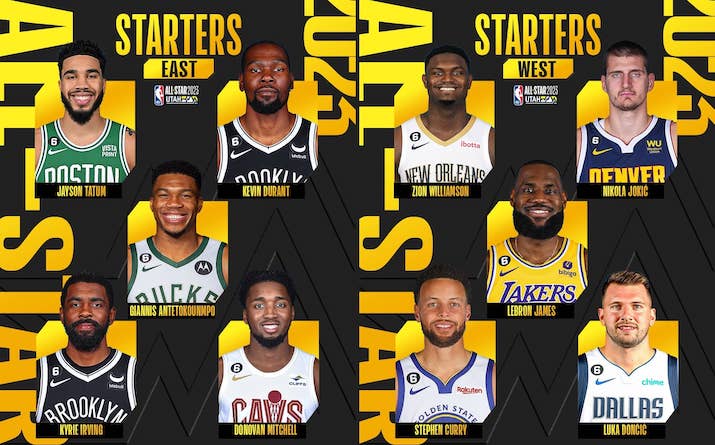Live From NBA All-Star 2023: WBD Sports Aims To Listen in on Player Conversations
Demand for on-field miking continues to grow as a way to engage fans
Story Highlights
Outfielders and broadcast announcers have been getting chattier over the past couple of seasons. What began as a Spring Training experiment became part of ESPN’s Sunday Night Baseball sound palette last season.
During this weekend’s NBA All-Star Game at Salt Lake City’s Vivint Arena, Dave Grundtvig, senior audio supervisor, remote operations, Warner Brothers Discovery Sports (WBD Sports), will apply that trick to basketball.
“It will be interesting,” he says, as he plots the conversation-capture strategy for the weekend. The protocols for using live player audio during the game are still being worked out with the league, which he says is enthusiastic about the idea.
“Getting player audio is always a matter of access,” notes Chris Brown, VP, production operations and technology, WBD Sports. “We work with the league and teams and players on that. The All-Star Game is an exhibition match, so there’s even more willingness to experiment and see what we can come up with.”
He adds that the beam-steering technology in the microphone arrays can further help in muting any unwanted audio (the muting is controlled from Atlanta) and helps reassure league officials and broadcast execs. “Our production executives are challenging us on the technology side to create ways to increase access for fans, within the league’s constraints.”
No Time for Leisurely Chats
Whereas baseball lends itself to conversation as outfielders wait for fly balls to head their way, basketball players are in constant motion at high levels of exertion. Grundtvig says the speed and dynamics of the game make it “uncharted territory” for athlete audio. Much of that sound will be reserved for replays, but the protocols for inserting some of it live on-air will be made up on the fly.
“We’ve done this during warm-ups ahead of games but never during the game itself,” he explains. “It’s a work in progress. The important thing is not to distract [the players] from the game with the earpiece.”
Moments to chat have to be chosen carefully, because players listen for the voices of their teammates, coaches, and opposing players as the game moves quickly from one end of the court to the other. The game dynamic can, says Grundtvig, “change in an instant.”
Changes in Audio Workflow
The network is using a combination of technology and workflow adjustments to address that. Several players on each side will be wearing Q5X PlayerMics, secured as usual in pouches sewn into their jerseys, and both teams’ coaches will have the company’s belt-worn QT-5100 CoachMics.
Normally, player audio is sent to an EVS system for delayed playback, usually during replays. For this game, however, some of the player audio will be broadcast in real time, albeit with a slightly extended 10-second profanity delay at the ready.
That is prompting workflow changes for the audio team. For starters, Grundtvig, who usually handles A1 duties and mixes the game’s broadcast audio, will serve as overall audio supervisor and sound designer. Two-time Emmy winner Matt Coppedge, who has handled CBS’s SEC shows, will do the game mix, and the effects submix will be handled by Brian Robertson, who is also A-1 for Bally Sports’ Orlando Magic, Tampa Bay Lightning, and Tampa Bay Rays broadcasts.
The PlayerMics will have their own separate submix, handled by Jeff Walker in a separate section of NEP EN-1’s audio compartment. In the past, he has managed those sources’ level and gain as well as the camera and robocam mics while Grundtvig mixed the player audio. Previously, all audio sources, including player and coach microphones, were mixed from the A1 desk.
Victor Victoria will manage the game’s RF while Nicholas Grundtvig and Jay Davis will serve as A2s on the floor, managing the arena effects microphones. Dave Grundtvig’s custom contact microphones, which he developed to capture court effects during the NBA’s COVID “bubble” in Orlando in 2020 and 2021, will be deployed in floor openings near each basket. Shure MXA710 beam-steerable microphone arrays — corporate-meeting products that he has adapted for broadcast-sports applications — will also be positioned near the baskets.
The effort is driven by ongoing and growing demand for real-time athlete audio, which Brown and Grundtvig agree adds significantly to viewer engagement.
“Last night,” says Grundtvig, who is set to work his 25th NBA All-Star Game, “we had [Milwaukee Bucks center] Brook Lopez wired up [against the L.A. Lakers], and he was tremendous. He was funny and insightful, and it was great that people could hear all of that. This is what brings you into the game on television.”

